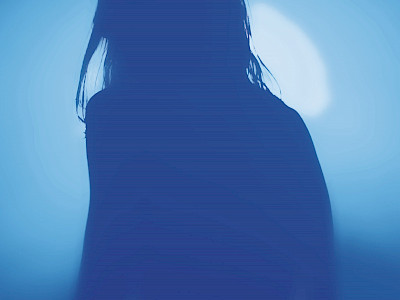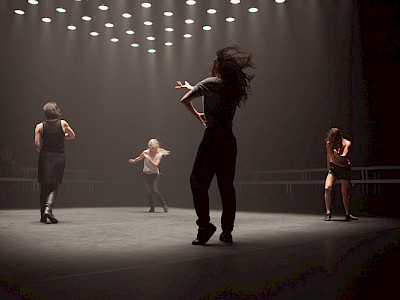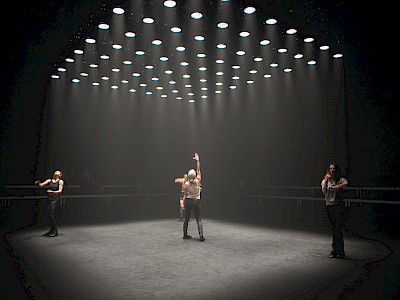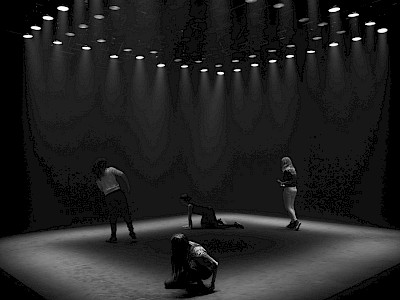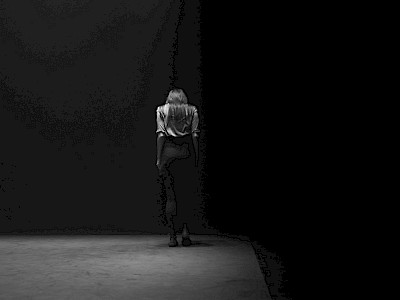22 — 25.05.2015
Engaged in writing down movement as much as creating completely perceptive experiences, with each and every project the young Belgian choreographer Louise Vanneste is developing a stage language that brings dance into dialogue with the space, the lighting and the sound. Her latest creation, which is being premiered at the festival, explores the tension between multiplicity and unity, between writing and instinct. The choreography is devised as four solos cohabiting in a single space. Inspired by gestures taken from the collective memory of rock concerts and popular dances, the performers unconsciously influence one another through their copresence rather than through an intentional exchange. They combine and recombine themselves into fleeting configurations ranging from a forlorn figure to a pack or to pairs. The lighting, sound and space are also used as autonomous objects that are part of the same strange and yet familiar organism, offered up for the audience’s perception. A magnetic performance.
Gone in a heartbeat
Questioning the group, not in terms of who is in it, but the gap, the distance or more precisely the “resemblance/difference” as Louise Vanneste likes to put it: one of the stances, going somewhat against the flow, she takes in Gone in a Heartbeat. A stance that leads almost entirely logically to another: not standardising the quartet with common writing, establishing an architecture in bodies without engraving a text or phrases on it, imbuing the performers with a vocabulary, a syntax and a context to enable them, individually, to breathe more easily in a shared language and space-time… A real concern (challenge) in choreographic writing that Louise Vanneste has in fact been exploring for almost five years, firstly in her solo, Home (2010), then in a duet with Eveline Van Bauwel, Black Milk (2013). Two early experiments with friction between “a search for a precise choreographic context and a desire to preserve the performer’s instinct and spontaneity” that Louise Vanneste is exploring in even greater depth here, this time by bringing together four bodies.
“Personally, fixing movements in itself is not what interests me. As a performer, I loved this idea of freedom, the experience of bodies on stage, bringing life on stage with all that it entails of the unknown, dangerous and risky... This is what my work initially focused on with states of the body’s presence. These states in a given context mean that the performers have sensors that inspire them on a sensorial level, and bring out a particular quality of movement. It’s also a way of showing performers who are alert and present in the moment, paying full attention to that instant, and not in the middle of executing or representing something.”
However, make no mistake: the performer’s freedom in the here and now is controlled by Louise Vanneste and also imprinted in a rhizome of individual and collective rules. “These instructions and tools are used to frame the space in which each dancer’s spontaneity can be expressed while giving me the opportunity to create moments and specific images. In terms of individual tools, for example, it involves each dancer imagining themselves in a particular situation or space (a bathroom, a swamp…) or as a particular figure (an old lady, a conqueror, a machine, an animal…). Free and variable guidance belonging to each one, allowing a precise personal vocabulary to be developed and to really live in the moment, because the brain has to continually call on the imagination to produce a certain physicality. Added to these individual tools are rules relating to the space and the other dancers: staying on the spot on stage, moving, going towards the others, creating a line together, passing one another, imitating the others, letting oneself be contaminated, taking another person’s movement as an impulse for your own movement etc. These different levels of rules and tools are juxtaposed and varied throughout the chronology of the piece. This collection of them provides the shared foundation for the four dancers. A foundation that allows them to work on the project’s basic idea: the relationship/non-relationship with the group… To give a specific example from the piece, at the start they have an instruction not to move and for each to develop a vocabulary of their own based on the same rule: to beat out a beat and play with it.”
In this research to bring choreographic instinct and writing together, the plastic and musical dimensions of the whole play a key role. Built, written and fixed throughout the creative process (in a game of ping pong with the refinement of choreographic rules and tools), ultimately the space, lighting and sound provide the backbone to Louise Vanneste’s creations, their dramaturgical focus almost, since the “territory” they create supports and crystallises this notion of states of presence that is central to her writing.
“I’m looking to create pieces in which it’s direct experience that counts more than anything. The dancer’s direct experience, but also the audience’s when confronted with the dancer, when confronted with the context (the music, lighting and space). Pieces in which it’s not about searching for a kind of logic or resolution, a kind of treatment of a particular theme… But it doesn’t mean they don’t exist or can’t be present; it just implies that they’re not the leitmotif or the driving force when the piece is being written or in whatever interpretation is made of it.”
In her bold and resolutely sensorial/sensual approach, what is being explored both by the performers and the audience alike is not so much the question of the present, but rather the process of letting go. “In general, for me, specifying or defining things or ideas is about risking locking them up in a unambiguous, absolute and immutable truth. I prefer the coexistence of possibilities and fully appreciate the ephemeral and furtive nature of things.” Gone in a Heartbeat to be precise…
Olivier Hespel
Concept & direction
Louise Vanneste
In collaboration with
Anja Röttgerkamp, Eléonore Valère-Lachky, Eveline Van Bauwel, Anuschka Von Oppen
Music
Cédric Dambrain
Scenography & lighting
Arnaud Gerniers, Benjamin van Thiel
Costumes
Filip Eyckmans
Production
Louise Vanneste/Rising Horses
Executive producer
Les Halles de Schaerbeek
Presentation
Kunstenfestivaldesarts, KVS
Co-production
Kunstenfestivaldesarts, Charleroi Danses, Théâtre de Liège, Le Phare Centre Chorégraphique National du Havre Haute-Normandie, Le Centre chorégraphique national Roubaix-Nord-Pas-de-Calais, Torinodanza
Louise Vanneste/Rising Horses is supported by
Fédération Wallonie-Bruxelles – Service de la danse, and accompanied by Grand Studio
Louise Vanneste is artist in residence at
Charleroi Danses & Les Halles de Schaerbeek

